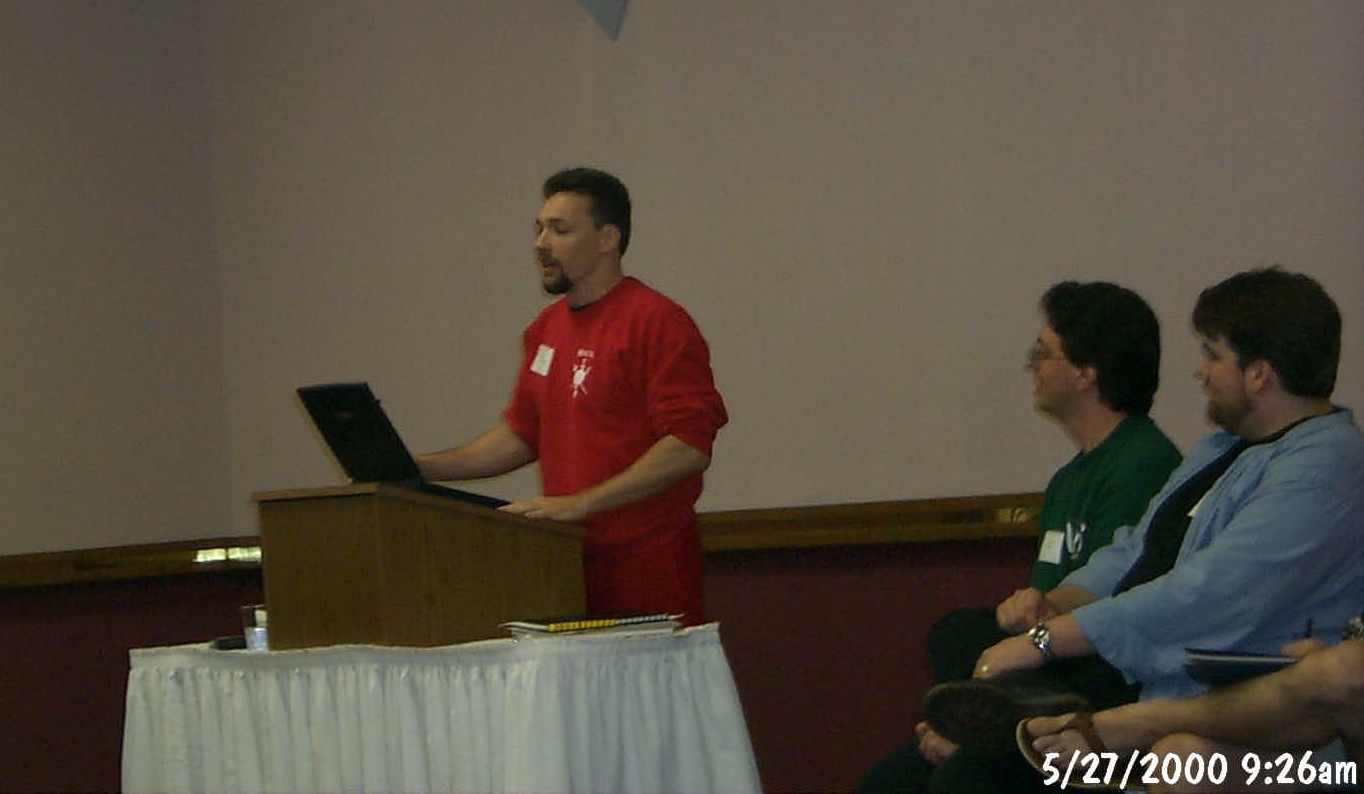 Editorial Editorial
Reconstructing
Renaissance Martial Arts: Two Analogies to Consider
By
John Clements
ARMA Director
Consider an analogy for a moment:
Let’s say you want to play ice hockey. But real ice hockey has been
extinct for some time. The new version you are doing is now played on a
different surface, using sticks that don’t weigh the same as the
originals nor have the same balance. Your puck is also a different size
and shape. Plus, the goal posts are not in quite the same location as
they were in the past. Even your skates are different than the
originals. You know that your new version is just an approximation of
the original, and you know that these differences have produced certain
idiosyncrasies and nuances that affect how you now go about it. You
skate differently than they did in the old days and you don’t guard or
swipe or even check in the same way. Having accepted such necessary
allowances you believe you've worked hard to become skillful within
these boundaries. You further realize that some time ago your enjoyable
new hockey ceased being a way to explore the original and has grown
instead into its own distinct pursuit with its own unique parameters.
A question therefore arises: At what point do you stop looking at the
original hockey —how its players moved and performed with their
equipment under their conditions— as your primary source of authority
and inspiration? At what point do you acknowledge that your current
understanding of “original hockey” has itself become profoundly colored
by the skill-set particular to your new version —a version that is at
best incongruous and at worst incompatible with how its was once played?
In the end, one could say that although your new hockey uses a
completely different scoring method, along with different equipment and
different techniques on a different surface, it at least provides better
insight into the original than does say, playing baseball. But the case
can be made that some of this “insight” may very well be as much
distortion as it is understanding. And for some, that then defeats the
very purpose for now doing it that way.
Consider a second analogy: If you’re going to take your great
grandmother’s old family recipe for chicken stew and switch out some
ingredients and change up the seasonings and then prepare it in a
somewhat different manner, well, as inspired as it might be from her
original dish, you’re making something entirely different now. You
really can’t call it your “grandmother’s famous country chicken stew"
any longer. You may have learned to make a tasty stew perfect for a
quick night’s meal, but you haven’t preserved the recipe, you haven’t
revised a forgotten dish, and you haven’t gained insight into her
old-school cooking style. If your attitude is, “I don’t really care
how they cooked in the past; I just want a good chicken stew today”,
then referencing grandma’s recipes hardly matters since you’re not
restoring but rather inventing. In which case, you cannot possibly make
any legitimate claim to either knowledge of, or expertise in, culinary
history.
As these two analogies convey, the important topic of reconstruction and
revival continues to surface as more material is discovered and
analyzed about the nature of (primarily) 16th century European
fight-school exhibitions. Many questions have been raised about them and
many have still yet to be satisfyingly answered. Such public events,
consisting of unarmored bouts with non-lethal weapons capable of drawing
blood and leaving tell-tale marks, were surely a major component of
acquiring and testing skill. But to what degree were such bloody
recreations displays of masculine valor, rights of passage, useful
training opportunities, divergences from class-room free-play, or
genuinely regulated sports?
 Back
in the early 2000s, I had a friendly debate with several professional Medievalists
at academic conferences over the issue of "knightly tourneys". They were
uniformly of the accepted opinion that such events were “preparation for
war”. That is, knights engaged in tourneys on horseback as practice for
real fighting. The same reasoning also applied to foot combat tournaments.
I challenged this view by asking them, then what was their practice for
these events? When and how did they train for combat on foot? The question
caught all of them off guard —no pun intended. I suggested that no knight
would possibly go into such an event without having first prepared himself
ahead of time through serious training. We agreed that was a logical assumption.
Hence, I pointed out the contradiction in the view that while a tourney
or tournament did offer good martial experience, it was not the source
for learning fighting techniques. Such practical self-defence skill had
to come from some other means of instruction that was then supplemented
by these pageant-filled recreational spectacles. I then argued that, in
particular, no knight entering a foot tournament would’ve done so without
undergoing some considerable martial arts lessons beforehand. Further, I
proposed such lessons would have surely been the result of veterans who
had engaged in real combat, not just tourneys and tournaments. There should
not have been anything controversial about this view and my opinion should
not have been an outlier. (It was certainly supported by already documented
evidence from 14th and 15th century fight book literature.) But, being myself
a practicing martial artist and explorer of Medieval and Renaissance combat
disciplines, I came to the subject with a very different conception than
did the pure academics. Back
in the early 2000s, I had a friendly debate with several professional Medievalists
at academic conferences over the issue of "knightly tourneys". They were
uniformly of the accepted opinion that such events were “preparation for
war”. That is, knights engaged in tourneys on horseback as practice for
real fighting. The same reasoning also applied to foot combat tournaments.
I challenged this view by asking them, then what was their practice for
these events? When and how did they train for combat on foot? The question
caught all of them off guard —no pun intended. I suggested that no knight
would possibly go into such an event without having first prepared himself
ahead of time through serious training. We agreed that was a logical assumption.
Hence, I pointed out the contradiction in the view that while a tourney
or tournament did offer good martial experience, it was not the source
for learning fighting techniques. Such practical self-defence skill had
to come from some other means of instruction that was then supplemented
by these pageant-filled recreational spectacles. I then argued that, in
particular, no knight entering a foot tournament would’ve done so without
undergoing some considerable martial arts lessons beforehand. Further, I
proposed such lessons would have surely been the result of veterans who
had engaged in real combat, not just tourneys and tournaments. There should
not have been anything controversial about this view and my opinion should
not have been an outlier. (It was certainly supported by already documented
evidence from 14th and 15th century fight book literature.) But, being myself
a practicing martial artist and explorer of Medieval and Renaissance combat
disciplines, I came to the subject with a very different conception than
did the pure academics.
Agonistic mock combat activities, whether or not to some degree
ritualized or sportified, have always been a component of warrior
training. It provides critical adversarial practice. But historical
warriors existed in a world where the violent reality of actual combat
was a constant reminder of what elements of personal combat were most
important. Classroom bouting, prize-playings, chivalric tournaments,
adjudicated duels of honor, friendly street rencounters, Klopfechter
displays, and the 17th century English "gladiatorial" matches were all
distinct forms of mock combat with their own peculiarities. Though they
may overlap in areas, each has its own purpose, structure, equipment,
approved participants, and target audience. This is a critical area of
interest for those of us trying today to understand —and accurately
recover— authentic Medieval and Renaissance self-defence methods.
Self-defence skills are always situational and contextual and they must
be examined with consideration to the milieu within they were developed
and used. Many times before I’ve addressed how this relates to our study
and practice: The approach you take to historical weapon practice —the
equipment you choose, the motives you follow, the objective you seek,
and the method you employ— colors and influences what you will achieve
from it.
A noticeable phenomenon is occurring now with youth who have entered
into this subject having had nearly their entire experience of medieval
and Renaissance martial arts based around competitive models that are
arguably reinvented versions of "modern sport fencing" —but with double
handed longs-swords or sword and buckler. Scoring points by using moves
that the rules of the refereed game prescribe, and not rediscovery of
historical self-defense methods, is how they approach the craft. Their
mindset is primarily directed to artificial recreational contests not
merely with blunt weapons but equipment often modified for scoring.
Sadly, this takes precedent over reference and deference to the reality
of how genuine combatants once employed real arms and armor in real
self-defence.
As suggested by the two analogies above, that this utterly alters their
perspective and interpretation of both the source teachings and
historical fight-school events, as well as completely changes their own
skill set, doesn’t seem to matter to some. In this regard, how it
compromises the original material is no different than what any other
modern competitive martial sport necessarily does as it deviates from
its historical fountainhead.
Thus, as both student and teacher I’ve long watched the phenomenon of
sportification of Medieval and Renaissance fencing (and even as far back
as 2001 prognosticated it’s eventual rise within our craft). It will be
interesting to see if my predictions of where it will lead and what its
ultimate effect will be continues to holds true. The obvious question is
how does an artificial focus on modern competition affect the
practitioner today trying to accurately re-constitute these lost
disciplines as a modern curriculum? ...A significant question indeed. In
the meantime, those of us concerned with authenticity and historicity
in recovering lost martial disciplines can only continue to follow our
own paths.
6-2020
|

